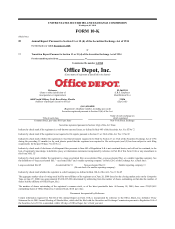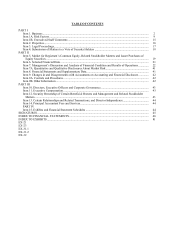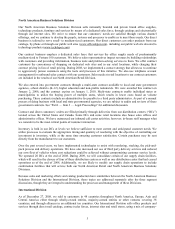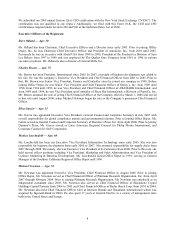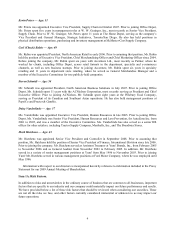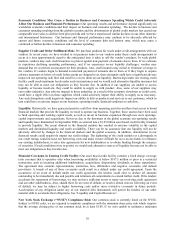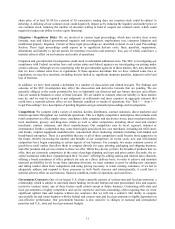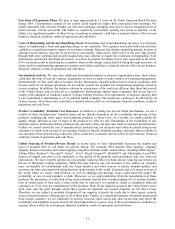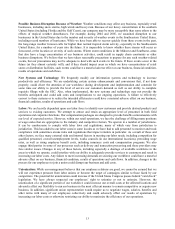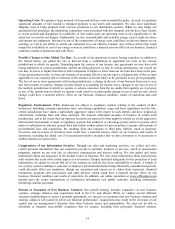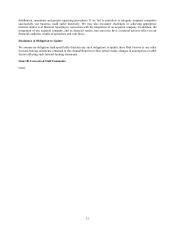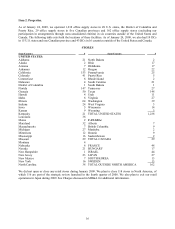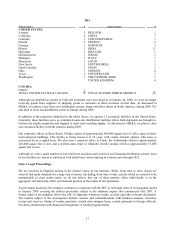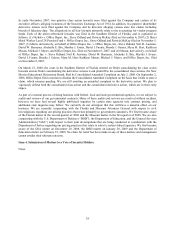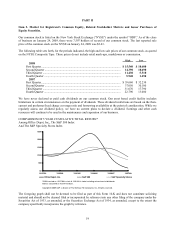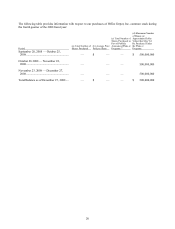Office Depot 2008 Annual Report Download - page 11
Download and view the complete annual report
Please find page 11 of the 2008 Office Depot annual report below. You can navigate through the pages in the report by either clicking on the pages listed below, or by using the keyword search tool below to find specific information within the annual report.10
Economic Conditions May Cause a Decline in Business and Consumer Spending Which Could Adversely
Affect Our Business and Financial Performance: Our operating results and performance depend significantly on
worldwide economic conditions and their impact on business and consumer spending. The decline in business and
consumer spending resulting from the global recession and the deterioration of global credit markets has caused our
comparable store sales to decline from prior periods and we have experienced similar declines in our other domestic
and international businesses. Our business and financial performance may continue to be adversely affected by
current and future economic conditions and the level of consumer debt and interest rates, which may cause a
continued or further decline in business and consumer spending.
Supplier Credit and Order Fulfillment Risk: We purchase products for resale under credit arrangements with our
vendors. In recent years, we have worked to set payment terms to our vendors under these credit arrangements to
occur at a time approximately equal to the anticipated time it takes to sell the vendor’s products. In weak global
markets, vendors may seek credit insurance to protect against non-payment of amounts due to them. If we continue
to experience declining operating performance, and if we experience severe liquidity challenges, vendors may
demand that we accelerate our payment for their products. Also, credit insurers may curtail or eliminate coverage to
the vendors. If vendors begin to demand accelerated payment of amounts due to them or if they begin to require
advance payments or letters of credit before goods are shipped to us, these demands could have a significant adverse
impact on our operating cash flow and result in a severe drain on our liquidity. Borrowings under our existing credit
facility could reach maximum levels under such circumstances and we would seek alternative liquidity measures but
may not be able to meet our obligations as they become due. In addition if our suppliers are unable to access
liquidity or become insolvent, they could be unable to supply us with product. Also, some of our suppliers may
serve other industries. Any adverse impacts to those industries, as a result of the economic slowdown or credit crisis,
could have a ripple effect on these suppliers which could adversely impact their ability to supply us as necessary.
Any such disruptions could negatively impact our ability to deliver products and services to our customers, which in
turn could have an adverse impact on our business, operating results, financial condition or cash flow.
Liquidity: Historically, we have generated positive cash flow from operating activities and have had access to broad
financial markets that provide the liquidity we need to operate our business. Together, these sources have been used
to fund operating and working capital needs, as well as invest in business expansion through new store openings,
capital improvements and acquisitions. However, due to the downturn in the global economy our operating results
and liquidity have diminished. In September 2008, we entered into a $1.25 billion asset based credit facility intended
to provide liquidity. The recent distress in the financial markets has resulted in extreme volatility in the capital
markets and diminished liquidity and credit availability. There can be no assurance that our liquidity will not be
adversely affected by changes in the financial markets and the global economy. In addition, deterioration in our
financial results could negatively impact our credit ratings. The tightening of the credit markets or a downgrade in
our credit ratings could increase our borrowing costs and make it more difficult for us to access funds, to refinance
our existing indebtedness, to enter into agreements for new indebtedness or to obtain funding through the issuance
of securities. If such conditions were to persist, we would seek alternative sources of liquidity but may not be able to
meet our obligations as they become due.
Financial Covenants in Existing Credit Facility: Our asset based credit facility contains a fixed charge coverage
ratio covenant that is operative only when borrowing availability is below $187.5 million or prior to a restricted
transaction, such as incurring additional indebtedness, acquisitions, dispositions, dividends, or share repurchases.
The agreement also contains representations, warranties, fees, affirmative and negative covenants, and default
provisions. A breach of any of these covenants could result in a default under our credit agreement. Upon the
occurrence of an event of default under our credit agreement, the lenders could elect to declare all amounts
outstanding to be immediately due and payable and terminate all commitments to extend further credit. If the lenders
accelerate the repayment of borrowings, we may not have sufficient assets to repay our revolving credit agreement
and our other indebtedness. Also, should there be an event of default, or need to obtain waivers following an event
of default, we may be subject to higher borrowing costs and/or more restrictive covenants in future periods.
Acceleration of any obligation under any of our material debt instruments will permit the holders of our other
material debt to accelerate their obligations. See “Liquidity and Capital Resources”.
New York Stock Exchange (“NYSE”) Compliance Risk: Our common stock is currently listed on the NYSE.
Subject to NYSE rules, we are required to maintain compliance with the minimum share price rule which requires
that the average closing price of our common stock be at least $1.00. If we were unable to maintain a minimum

